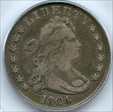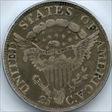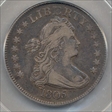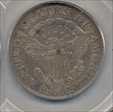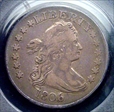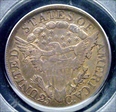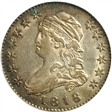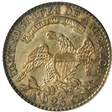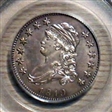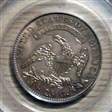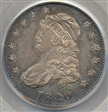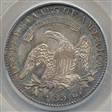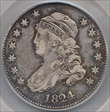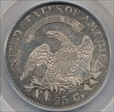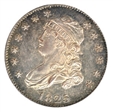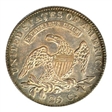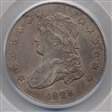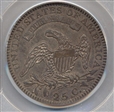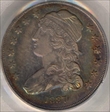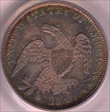rfar 的钱币相册
1818/5 25C AU55 PCGS. B-1, R3. Population (PCGS 2/39, NGC 4/51). Die State II, A briefly circulated, attractively toned example of this Guide Book overdate, lightly marked overall with a touch of wear on the highpoints. Both sides display faint die cracks and lovely peach and blue-gray patina. The reverse is rotated approximately 20 degrees counterclockwise.
1818/5 25C AU55 PCGS. B-1, R3. Population (PCGS 2/39, NGC 4/51). Die State II, A briefly circulated, attractively toned example of this Guide Book overdate, lightly marked overall with a touch of wear on the highpoints. Both sides display faint die cracks and lovely peach and blue-gray patina. The reverse is rotated approximately 20 degrees counterclockwise.
1819 25C Small 9 AU58 PCGS. B-3, R1. Population (PCGS 5/18, NGC 1/4). Die State II, Colon After 25C: The 9 in the date is mostly centered beneath Liberty's lowest hair curl. On the reverse the ED in UNITED is aligned, with the D somewhat higher. The 25 in the denomination is re-punched, the 2 lightly, the 5 broadly. A light die crack from the rim through star 11 to the bust, and a slender diagonal crack though the bust truncation and the first 1 in the date to the rim, otherwise the dies are perfect. Encapsulated in a green label holder. Both sides of this wondrously preserved example has surfaces drenched in a sea-green and pearl-gray with occasional overlays of subtle steel-blue toning draping this satiny and attractively preserved Bust Quarter. The strike is exemplary.
1819 25C Small 9 AU58 PCGS. B-3, R1. Population (PCGS 5/18, NGC 1/4). Die State II, Colon After 25C: The 9 in the date is mostly centered beneath Liberty's lowest hair curl. On the reverse the ED in UNITED is aligned, with the D somewhat higher. The 25 in the denomination is re-punched, the 2 lightly, the 5 broadly. A light die crack from the rim through star 11 to the bust, and a slender diagonal crack though the bust truncation and the first 1 in the date to the rim, otherwise the dies are perfect. Encapsulated in a green label holder. Both sides of this wondrously preserved example has surfaces drenched in a sea-green and pearl-gray with occasional overlays of subtle steel-blue toning draping this satiny and attractively preserved Bust Quarter. The strike is exemplary.
1820 25C Small O AU58 PCGS. B-4, R2. Population (PCGS 8/9, NGC 1/1). The relationship between the quarter and half dollar during this era is similar to that between the half cent and large cent. The larger denomination was preferred in commerce, and had significantly higher mintages. Aside from the 1815, the 1820 is the lowest mintage year of the Capped Bust half series. Yet its mintage of 751,122 pieces is more than five times that of the 127,444 quarters struck that year. The date has a small 8, star 7 points to the lower part of the cap, and the I in PLURIBUS is centered under the left stand of the second T in STATES. Splashes of blue, olive-green, and purple intermingle over quite clean surfaces that retain a fair amount of luster. Sharp definition is apparent on all of the design features.
1820 25C Small O AU58 PCGS. B-4, R2. Population (PCGS 8/9, NGC 1/1). The relationship between the quarter and half dollar during this era is similar to that between the half cent and large cent. The larger denomination was preferred in commerce, and had significantly higher mintages. Aside from the 1815, the 1820 is the lowest mintage year of the Capped Bust half series. Yet its mintage of 751,122 pieces is more than five times that of the 127,444 quarters struck that year. The date has a small 8, star 7 points to the lower part of the cap, and the I in PLURIBUS is centered under the left stand of the second T in STATES. Splashes of blue, olive-green, and purple intermingle over quite clean surfaces that retain a fair amount of luster. Sharp definition is apparent on all of the design features.
1825/2 25C AU58 PCGS. B-1, R5. Population (PCGS 5/2, NGC 3/1). The B-1 variety is easily the rarest of the three 1825 die marriages, and it is extremely difficult to locate in higher grades. As such it receives a separate Guide Book listing, as it is the only 1825/2 variety. It can be identified by the high location of star 8 relative to the cap. In addition, there are obvious curves of the under-digit 2, the first 8 in the date is also boldly re-cut and a lengthy mint-made spine from the back of the lowest arrowhead confirms the reverse die. In his revision of Browning, Walter Breen recorded two die states, either perfect or with die crumbling inside the digit 5. The other two die pairings of the year, B-2 and B-3 are variously described as 1825/4, 1825/3, and 1825/4/3. The present boldly struck near-Mint example has only delicate sky-gray and gold tints on the obverse, the reverse has a peach center bounded by lighter cream toning. Unmarked for the grade, the obverse is somewhat proof-like the reverse displays extensive cartwheel shimmer. The dies are lightly clashed but otherwise perfect.
1825/2 25C AU58 PCGS. B-1, R5. Population (PCGS 5/2, NGC 3/1). The B-1 variety is easily the rarest of the three 1825 die marriages, and it is extremely difficult to locate in higher grades. As such it receives a separate Guide Book listing, as it is the only 1825/2 variety. It can be identified by the high location of star 8 relative to the cap. In addition, there are obvious curves of the under-digit 2, the first 8 in the date is also boldly re-cut and a lengthy mint-made spine from the back of the lowest arrowhead confirms the reverse die. In his revision of Browning, Walter Breen recorded two die states, either perfect or with die crumbling inside the digit 5. The other two die pairings of the year, B-2 and B-3 are variously described as 1825/4, 1825/3, and 1825/4/3. The present boldly struck near-Mint example has only delicate sky-gray and gold tints on the obverse, the reverse has a peach center bounded by lighter cream toning. Unmarked for the grade, the obverse is somewhat proof-like the reverse displays extensive cartwheel shimmer. The dies are lightly clashed but otherwise perfect.
1828 25C 25 over 50C EF45 PCGS. B-3, R4. Population (PCGS 1/10, NGC 0/7). This is one of the most famous engraving errors in American numismatics. First introduced on the reverse die of the 1822 quarter this die was briefly resurrected, on the grounds of economy, and used once again in the striking of the 1828 Browning-3 variety shown here. Browning, in elaborating on the 25 over 50, wrote "...the engraver evidently mistook the die for that of a 50-cent piece, then corrected the error; ..." The die engraver used the denomination punches for a half dollar, and first engraved 50 C. instead of 25 C. Then realizing the mistake, he corrected this by engraving the correct 25 over the 50. This variety is always in very strong demand, and short supply as witnessed by the PCGS & NGC population reports, for the curious denomination error and one of the most popular of the early quarter die varieties. For the specialist, this coin represents a major achievement when added to a variety collection.
1828 25C 25 over 50C EF45 PCGS. B-3, R4. Population (PCGS 1/10, NGC 0/7). This is one of the most famous engraving errors in American numismatics. First introduced on the reverse die of the 1822 quarter this die was briefly resurrected, on the grounds of economy, and used once again in the striking of the 1828 Browning-3 variety shown here. Browning, in elaborating on the 25 over 50, wrote "...the engraver evidently mistook the die for that of a 50-cent piece, then corrected the error; ..." The die engraver used the denomination punches for a half dollar, and first engraved 50 C. instead of 25 C. Then realizing the mistake, he corrected this by engraving the correct 25 over the 50. This variety is always in very strong demand, and short supply as witnessed by the PCGS & NGC population reports, for the curious denomination error and one of the most popular of the early quarter die varieties. For the specialist, this coin represents a major achievement when added to a variety collection.
Originally in the Dayers collection. Purchased from R. Uhrich at the Baltimore Coin Convention in '10.
Originally in the Dayers collection. Purchased from R. Uhrich at the Baltimore Coin Convention in '10.




















